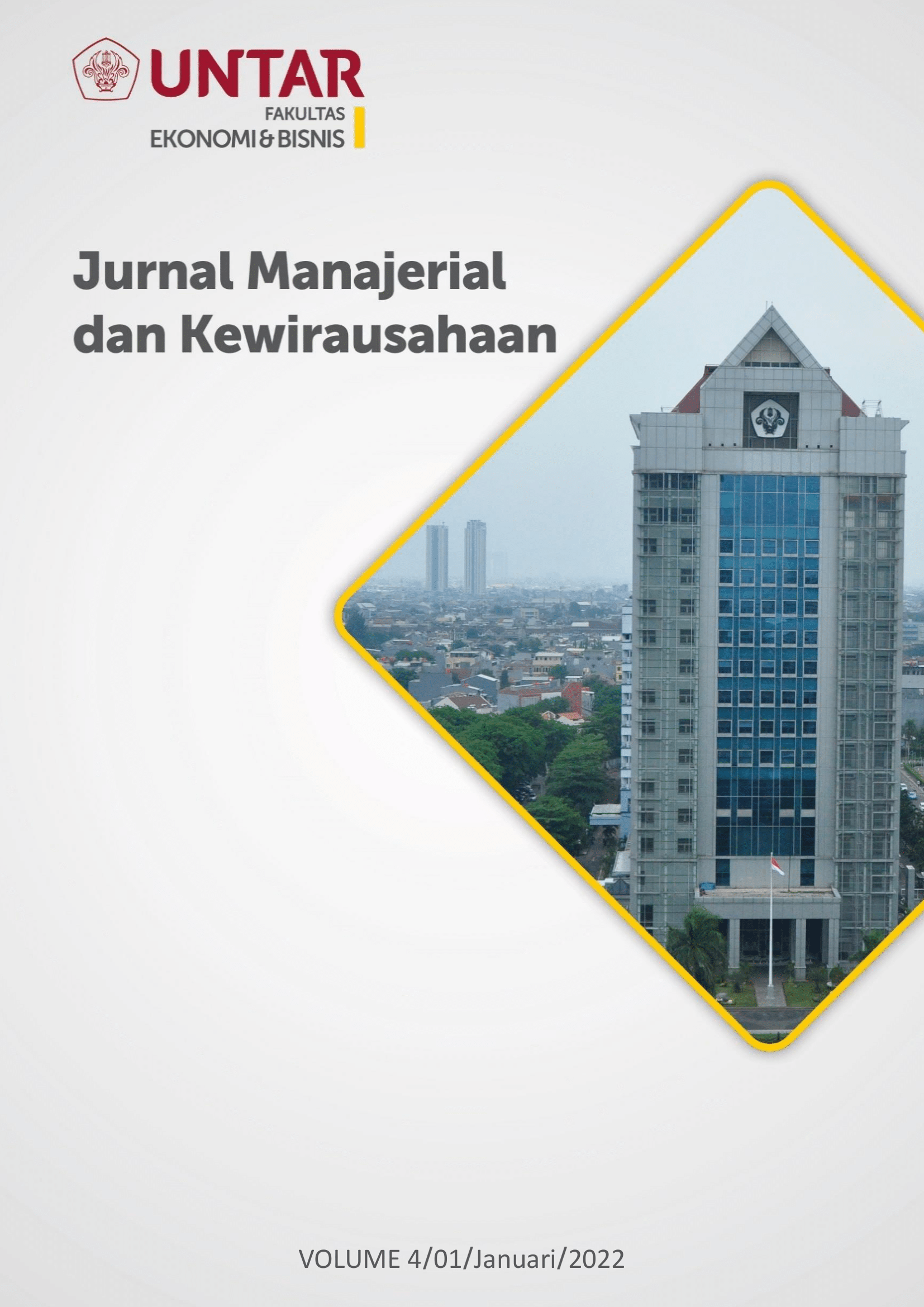Faktor-Faktor yang Memengaruhi Intensi Berwirausaha Generasi Milenial di Jakarta
Main Article Content
Abstract
Pendidikan kewirausahaan adalah sebuah proses yang bertujuan untuk memicu individu dalam berwirausaha dengan cara memberikan ilmu pengetahuan, keahlian dan keterampilan yang berhubungan dengan kreatifitas dan pengenalan peluang untuk penciptaan usaha baru. Kemudian, modal finansial adalah bentuk sumber daya yang diperlukan sebagai alat transaksi dalam memulai kegiatan usaha untuk mencapai hasil yang diinginkan. Penelitian ini bertujuan untuk mengetahui pengaruh pendidikan kewirausahaan dan modal finansial terhadap intensi berwirausaha dengan metode kuantitatif yang berjenis konklusif dan cross-sectional design. Dalam penelitian ini, data diperoleh secara online dengan menggunakan google form, yang dikirimkan melalui Whatsapp, Instagram, dan Line terhadap 90 responden yang merupakan generasi milenial dan berdomisili di Jakarta dengan metode non-probability sampling (convenience sampling). Kemudian, terdapat 2 (dua) hipotesis dalam penelitian ini yang dianalisis menggunakan PLS-SEM dengan software Smart Partial Least Square 3.0. Hasil penelitian ini menunjukkan bahwa pendidikan kewirausahaan dan modal finansial masing-masing memiliki pengaruh yang positif dan signifikan terhadap intensi berwirausaha generasi milenial di Jakarta.
Entrepreneurship education is a process that aim to trigger individuals in entrepreneurship by providing knowledge, expertise and skills related to creativity and the introduction of opportunities for the creation of new businesses. Then, financial capital is a form of resources needed as a transaction tool in starting business activities to achieve the desired results. This study aims to determine the effect of entrepreneurship education and financial capital on entrepreneurial intentions with conclusive quantitative methods and cross-sectional design. In this study, data was obtained online using a google form, which was sent via Whatsapp, Instagram, and Line to 90 respondents who are millennials and live in Jakarta using the non-probability sampling method (convenience sampling). Then, there are 2 (two) hypotheses in this study which were analyzed using PLS-SEM with Smart Partial Least Square 3.0 software. The results of this study indicate that entrepreneurship education and financial capital each have a positive and significant influence on the entrepreneurial intention of the millennial generation in Jakarta.
Article Details
This work is licensed under a Jurnal Muara Ilmu Ekonomi dan Bisnis Creative Commons Attribution-ShareAlike 4.0 International License.,/p>
References
Ajzen, I. (1991). The theory of planned behavior. Organizational Behavior and Human Decision Processes, 50(2), 179-211.
Da Cruz, J. V. (2018). Beyond financing: crowdfunding as an informational mechanism. Journal of Business Venturing, 33(3), 371-393.
Daniel., & Handoyo, S. E. (2021). Pengaruh Pendidikan Kewirausahaan, Lingkungan, dan Motivasi Berwirausaha Terhadap Intensi Berwirausaha Mahasiswa. Jurnal Manajemen dan Kewirausahaan, 3(4), 944-952.
Echchabi, A., Omar, M. M. S., & Ayedh, A. M. (2020). Entrepreneurial intention among female university students in Oman. Journal for International Business and Entrepreneurship Development, 12(4), 280-297.
Fisch, C. (2019). Initial coin offerings (ICOs) to finance new ventures. Journal of Business Venturing, 34(1), 1-22.
Garson, G. D. (2016). Partial Least Squares: Regression & Structural Equation Models. North Carolina: Statistical Associates Publishing.
Gaddefors, J., & Anderson, A. R. (2017). Entrepreneursheep and context: when entrepreneurship is greater than entrepreneurs. International Journal of Entrepreneurial Behavior & Research, 23(2), 267?278.
Ghozali, I., & Latan, H. (2014). Structural equation modeling, metode alternatif dengan Partial Least Square (PLS). Edisi 4. Semarang: Badan Penerbit Universitas Diponegoro.
Hair, J. F., Ringle, C. M., & Sarstedt, M. (2011). PLS-SEM Indeed a silver bullet. The Journal of Marketing Theory and Practice, 19(2), 139-151.
Hair, J. F., Risher, J. J., Sarstedt, M., & Ringle, C. M. (2019). When to use and how to report the results of PLS-SEM. European Business Review, 31(1), 2-24.
Hahn, D., Minola, T., Van Gils, A., & Huybrechts, J. (2017). Entrepreneurial education and learning at universities: exploring multilevel contingencies. Entrepreneurship and Regional Development, 29(9), 945-974.
Hasliza, H., Abu, B. S., & Muhammad, S. R. (2020). Shaping entrepreneurial intention among youngsters in Malaysia. Journal of Humanities and Applied Social Sciences, 2(3), 235-251.
Henseler, J., Ringle, C. M., & Sinkovics, R. R. (2009). The Use of Partial Least Squares Path Modeling In International Marketing. New Challenges to International Marketing Advances in International Marketing, 20, 277–319.
Hockerts, K. (2018). The effect of experiential social entrepreneurship education on intention formation in students. Journal of Social Entrepreneurship, 9(3), 234-256.
Hynes, B. (2006). Entrepreneurship education and training: introducing entrepreneurship into non-business disciplines. Journal of European Industrial Training, 20(8), 10-17.
Tanazha, J., & Budiono, H. (2021). Pengaruh Pendidikan Kewirausahaan, Efikasi Diri, Kepribadian dan Peran Faktor Keluarga Terhadap Niat Berwirausaha. Jurnal Manajemen dan Kewirausahaan, 3(3), 751-761.
Kew, J., Herrington, M., Litovsky, Y., & Gale, H. (2013). Generation Entrepreneur? The State of Global Youth Entrepreneurship. Newcastle: Youth Business International and Global Entrepreneurship.
Lin?an, F., & Fayolle, A. (2015). A systematic literature review on entrepreneurial intentions: citation, thematic analyses, and research agenda. International Entrepreneurship and Management Journal, 11(4), 907-933.
Lin?an, F., Santos, F. J., & Fernandez, J. (2011). The influence of perceptions on potential entrepreneurs. International Entrepreneurship and Management Journal, 7(3), 373–390.
Ozaralli, N. & Rivenburgh, N. (2016). Entrepreneurial intention: antecedents to entrepreneurial behavior in the USA and Turkey. Journal of Global Entrepreneurship Research, 6(3), 2-32.
Santos, F. J., Roomi, M. A., & Linan, F. (2016). About gender differences and the social environment in the development of entrepreneurial intentions. Journal of Small Business Management, 54(1), 49-66.
Tenenhaus, M. (2004). PLS Regression and PLS Path Modeling for Multiple Table Analysis. COMPSTAT 2004 Proceedings. Würzburg. Berlin.
Wei-Loon, K. (2013). Entrepreneurial orientation and performance of government-linked companies. Journal of Entrepreneurship Management and Innovation, 9(3), 21-41.



